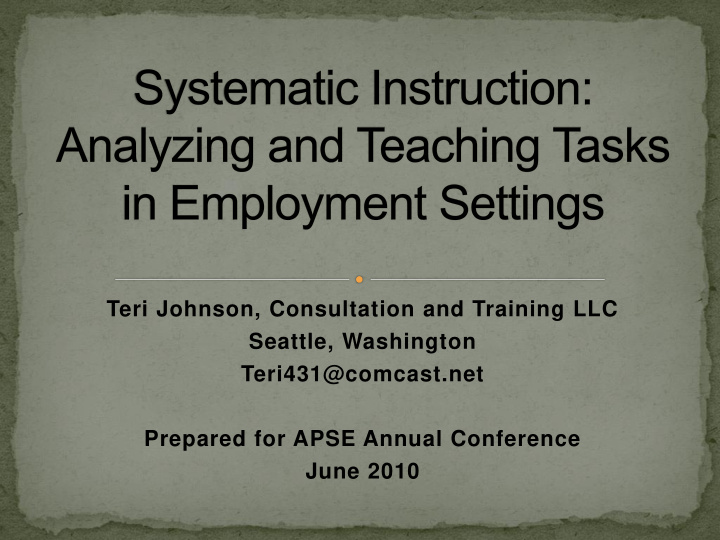



Teri Johnson, Consultation and Training LLC Seattle, Washington Teri431@comcast.net Prepared for APSE Annual Conference June 2010
An approach in response to what was once accepted belief… that label and/or IQ score predicted ability to learn “Only a medical man could fully appreciate the educational needs of idiots while also providing the necessary diagnostic tools to separate the idiot, who was amenable to training, from the idiot encumbered by other disabilities, who was not.” Seguin, 1866 1906 Rome State Custodial Asylum for Unteachable Idiots 1917 Faribault School for the Training of Imbeciles and the Custody of Idiots
Marc Gold, University of Illinois, Try Another Way Paul Wehman, Virginia Commonwealth University, Rehabilitation Research and Training Center Lou Brown, University of Wisconsin Tom Bellamy, University of Oregon, Specialized Training Program
His students with developmental disabilities had much more potential than anyone realized. All people with disabilities should have the opportunity to live their lives much like everyone else. Everyone can learn if we can figure out how to teach them. A lack of learning should first be interpreted as insufficient use of teaching strategies rather than inability of the learner.
Loose teaching is not getting the person where they want or need to be. Learning style is best accommodated by systematic instruction. Activity or task has element of risk if not done correctly.
Assessment Job Development Job Analysis Teaching / Training Follow-along Support
• Task Design • Task Analysis • Delivering and Fading Assistance • Utilizing Reinforcement • Assessing Progress • Implementing Self-Management
Appropriate – defined in relation to several factors… Universal Design Efficiency and physical ease Supports learning and independence Standard work versus customized for individual
• Physical Ease • Independence • Efficiency
Following job analysis, identification of job tasks and in response to individual need. Focuses trainer attention on the specific demands of the task and cues within the task. Breaks the task into discreet, observable steps and lists in order.
Clerical Assistant Tasks: Check water coolers in Reception Rooms 1 and 2; replace if less than ¼ full Make coffee and replenish cream/sugar in Reception Rooms 1 and 2 Check paper and toner level in copiers (8) and fill as needed Check for pads and pens in Training Room; replace as needed Fill soda machine as needed
• Task Design • Task Analysis • Delivering and Fading Assistance • Utilizing Reinforcement • Assessing Progress • Implementing Self-Management
Providing additional cues (information) as needed to enable a correct response. Methods will vary: Verbal Written Modeling Physical prompts / gestures Match to sample Physical guidance
Take your cue from the learner; learner performance will guide you. When providing assistance: Give no more than minimum to get correct answer Anticipate and avoid errors “Tie” your assistance to the cues in the task
Valuable tool in building and strengthening new skills • Discreet and appropriate for the settng • Individualized • Faded to whatever level will be available when training ends
Thank you for attending today. See you in Seattle next Summer!
Recommend
More recommend